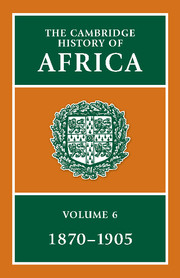Book contents
- Frontmatter
- Introduction
- 1 Africa on the Eve of Partition
- 2 The European Partition of Africa: Origins and Dynamics
- 3 North Africa
- 4 Western Africa, 1870–1886
- 5 Western Africa, 1886–1905
- 6 Western Equatorial Africa
- 7 Southern Africa, 1867–1886
- 8 Southern and Central Africa, 1886–1910
- 9 Portuguese Colonies and Madagascar
- 10 East Africa 1870–1905
- 11 The Nile Basin and the Eastern Horn, 1870–1908
- 12 The European Scramble and Conquest in African History
- Bibliographical Essays
- Bibliography
- Index
- Map 9 West Africa, c. 1870">
- Map 10 West Africa, c. 1905
- Map 13 The Congo Independent State
- Map 26 Ethiopia, the Nile Valley and the Horn in the era of Menelik II
- References
11 - The Nile Basin and the Eastern Horn, 1870–1908
Published online by Cambridge University Press: 28 March 2008
- Frontmatter
- Introduction
- 1 Africa on the Eve of Partition
- 2 The European Partition of Africa: Origins and Dynamics
- 3 North Africa
- 4 Western Africa, 1870–1886
- 5 Western Africa, 1886–1905
- 6 Western Equatorial Africa
- 7 Southern Africa, 1867–1886
- 8 Southern and Central Africa, 1886–1910
- 9 Portuguese Colonies and Madagascar
- 10 East Africa 1870–1905
- 11 The Nile Basin and the Eastern Horn, 1870–1908
- 12 The European Scramble and Conquest in African History
- Bibliographical Essays
- Bibliography
- Index
- Map 9 West Africa, c. 1870">
- Map 10 West Africa, c. 1905
- Map 13 The Congo Independent State
- Map 26 Ethiopia, the Nile Valley and the Horn in the era of Menelik II
- References
Summary
EGYPT: THE END OF ISMĀ'īL'S REIGN, 1876–79
In the 1870s Egypt had a population of about 7 million, some 90 per cent of it rural. Its economy was dominated by the production and export of cotton, which had increased fourfold in the 1860s, and by the later 1870s represented 75 per cent of Egypt's exports by value. Capital inputs, notably Khedive Ismā'īl's enormous foreign borrowings, tended further to strengthen the dominant export sector by improvements to water-supply, internal transport and harbours; and by providing this sector with relatively sophisticated banking, brokerage and marketing services. Otherwise, capital flowed into Ismā'īl's quest for African empire; and into the development of the new, European-style quarters of Cairo and Alexandria. A little went into the primary processing of agricultural products (cotton-ginning, sugar-refining). But building and primary processing could not initiate an industrial revolution.
Nor had there been a revolution in the actual processes of agricultural production. Egyptian agriculture remained highly labour-intensive. Its equipment was simple, even primitive, and extravagant in its use of human and animal muscle-power. Especially in the corvée whereby the irrigation system was maintained, the fallāhīn often worked virtually with their bare hands. In contrast, the financing of cotton production and the marketing of the product had created an exotic and precociously developed financial and commercial superstructure, dominated by foreign residents who were, thanks to the Capitulations, largely exempt from Egyptian taxation and from Egyptian administrative and legal control. By 1880 there were perhaps 70,000 resident foreigners in Egypt.
Keywords
- Type
- Chapter
- Information
- The Cambridge History of Africa , pp. 592 - 679Publisher: Cambridge University PressPrint publication year: 1985
References
- 2
- Cited by

